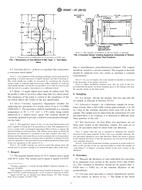Wir benötigen Ihre Einwilligung zur Verwendung der einzelnen Daten, damit Sie unter anderem Informationen zu Ihren Interessen einsehen können. Klicken Sie auf "OK", um Ihre Zustimmung zu erteilen.
ASTM D7747/D7747M-11e1
Standard Test Method for Determining Integrity of Seams Produced Using Thermo-Fusion Methods for Reinforced Geomembranes by the Strip Tensile Method (Includes all amendments And changes 2/22/2018).
Automatische name übersetzung:
Standard Test Methode zur Bestimmung der Integrität der Nähte, die unter Verwendung von Thermo-Fusion-Verfahren zur Verstärkte Dichtungsbahnen nach dem Strip Tensile Methode
NORM herausgegeben am 1.10.2011
Informationen über die Norm:
Bezeichnung normen: ASTM D7747/D7747M-11e1
Anmerkung: UNGÜLTIG
Ausgabedatum normen: 1.10.2011
SKU: NS-39054
Zahl der Seiten: 6
Gewicht ca.: 18 g (0.04 Pfund)
Land: Amerikanische technische Norm
Kategorie: Technische Normen ASTM
Kategorie - ähnliche Normen:
Die Annotation des Normtextes ASTM D7747/D7747M-11e1 :
Keywords:
ICS Number Code 59.080.70 (Geotextiles)
Ergänzende Informationen
| Significance and Use | ||||||||||
|
4.1 The use of reinforced geomembranes as barrier materials has created a need for a standard test method to evaluate the quality of seams produced by thermo-fusion methods. This test method is used for quality control purposes and is intended to provide quality control and quality assurance personnel with data to evaluate seam quality. 4.2 This standard arose from the need for a destructive test method for evaluating seams of reinforced geomembranes. Standards written for destructive testing of nonreinforced geomembranes do not include all Break Codes (4.3 When reinforcement occurs in directions other than machine and cross machine, scrim are cut at specimen edges, generally lowering results. To partially compensate for this, testing can be performed according to Test Method D7749, or the 2 in. wide strip specimen specified in this method can be utilized. Testing of 1 in. and 2 in. specimens is Method A and Method B respectively. 4.4 The shear test outlined in this method correlates to strength of parent material measured according to Test Method D7003/D7003M only if reinforcement is parallel to TD. For other materials, seam strength and parent material strength can be compared through Test Methods D7749 and D7004/D7004M. Values obtained with the strip methods shall not be compared to values obtained with grab methods. |
||||||||||
| 1. Scope | ||||||||||
|
1.1 This test method describes destructive quality control tests used to determine the integrity of thermo-fusion seams made with reinforced geomembranes. Test procedures are described for seam tests for peel and shear properties using strip specimens. 1.2 The types of thermal field and factory seaming techniques used to construct geomembrane seams include the following: 1.2.1 Hot Air—This technique introduces high-temperature air between two geomembrane surfaces to facilitate melting. Pressure is applied to the top or bottom geomembrane, forcing together the two surfaces to form a continuous bond. 1.2.2 Hot Wedge—This technique melts the two geomembrane surfaces to be seamed by running a hot metal wedge between them. Pressure is applied to the top and bottom geomembrane to form a continuous bond. Some seams of this kind are made with dual tracks separated by a non-bonded gap. These seams are sometimes referred to as dual hot wedge seams or double-track seams. 1.2.3 Extrusion—This technique encompasses extruding molten resin between two geomembranes or at the edge of two overlapped geomembranes to effect a continuous bond. 1.2.4 Radio Frequency (RF) or Dielectric—High frequency dielectric equipment is used to generate heat and pressure to form an overlap seam in factory fabrication. 1.2.5 Impulse—Clamping bars heated by wires or a ribbon melts the sheets clamped between them. A cooling period while still clamped allows the polymer to solidify before being released. 1.3 The types of materials covered by this test method include, but are not limited to, reinforced geomembranes made from the following polymers: 1.3.1 Very Low Density Polyethylene (VLDPE). 1.3.2 Linear Low Density Polyethylene (LLDPE). 1.3.3 Flexible Polypropylene (fPP). 1.3.4 Polyvinyl Chloride (PVC). 1.3.5 Chlorosulfonated polyethylene (CSPE). 1.3.6 Ethylene Interpolymer Alloy (EIA). 1.4 Units—The values stated in either SI units or inch-pound units are to be regarded separately as standard. The values stated in each system may not be exact equivalents; therefore, each system shall be used independently of the other. Combining values from the two systems may result in non-conformance with the standard. 1.5 This standard does not purport to address all of the safety concerns, if any, associated with its use. It is the responsibility of the user of this standard to establish appropriate safety and health practices and determine the applicability of regulatory limitations prior to use. |
||||||||||
| 2. Referenced Documents | ||||||||||
|
Ähnliche Normen:
Historisch
1.1.2014
Historisch
1.6.2009
Historisch
1.6.2011
Historisch
1.7.2012
Historisch
1.6.2011
Historisch
1.6.2009
Empfehlungen:
Aktualisierung der technischen Normen
Wollen Sie sich sicher sein, dass Sie nur die gültigen technischen Normen verwenden?
Wir bieten Ihnen eine Lösung, die Ihnen eine Monatsübersicht über die Aktualität der von Ihnen angewandten Normen sicher stellt.
Brauchen Sie mehr Informationen? Sehen Sie sich diese Seite an.



 ASTM D5321/D5321M-14..
ASTM D5321/D5321M-14.. ASTM D5322-98(2009)..
ASTM D5322-98(2009).. ASTM D5323-92(2011)..
ASTM D5323-92(2011).. ASTM D5397-07(2012)..
ASTM D5397-07(2012).. ASTM D5493-06(2011)..
ASTM D5493-06(2011).. ASTM D5496-98(2009)..
ASTM D5496-98(2009)..
 Cookies
Cookies
